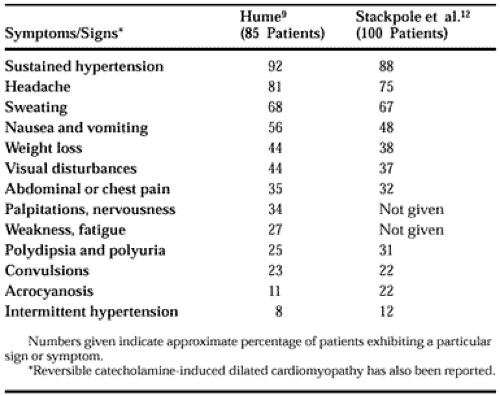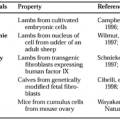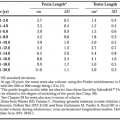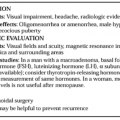PHEOCHROMOCYTOMA
Less than 5% of all pheochromocytoma cases occur in childhood. Pheochromocytoma is approximately twice as common in boys as in girls. In children, most tumors occur in the adrenal medulla, but they may also be found in aberrant tissue along the sympathetic chain, the thorax, the paraaortic area, the aortic bifurcation, the retroperitoneum, and the bladder. In children with pheochromocytoma, the incidence of malignant adrenal tumors has been reported to be as high as 25%.10
CLINICAL FEATURES
The symptoms and signs of pheochromocytoma in children are presented in Table 87-3. Pheochromocytomas in pediatric patients are extremely variable in clinical presentation, which can lead to delay in diagnosis.11 In a large review of 100 children, 140 tumors were found.12 Sixty-eight patients had single tumors, 19 of which were extraadrenal. Among the 32 patients with two or more tumors, 20 had bilateral adrenal tumors, 8 had both intraadrenal and extraadrenal tumors, and 4 had multiple extraadrenal tumors.
The association of pheochromocytoma with neurocutaneous syndromes is well known. These syndromes include mucosal neuromas (see Chap. 188) and neurofibromatosis. Bilateral pheochromocytoma may occur in patients with von Hippel-Lindau disease (a syndrome characterized by dominantly inherited angiomatosis of the retina, cerebellar angioma, and angiomas of other organs).13 Extraadrenal pheochromocytoma may be found in patients with the triad of Carney (gastric epithelioid leiomyosarcoma, pulmonary chondroma, and functioning extraadrenal paraganglioma).14
LABORATORY FINDINGS
As in adults, in children the definitive diagnosis of pheochromocytoma requires the detection of elevated urine or blood levels of catecholamines and their metabolites (Fig. 87-1). Generally, discontinuing all medications at least 2 weeks before obtaining urine collections is wise.
 FIGURE 87-1. Serum and urinary constituents used for the diagnosis of pheochromocytoma. Norepinephrine and epinephrine are converted to normetanephrine and metanephrine, respectively, by the enzyme catechol-O-methyltransferase. Normetanephrine and metanephrine are then converted to vanillylmandelic acid by the enzyme monamine oxidase. (See Chap. 85 for details.)
Stay updated, free articles. Join our Telegram channel
Full access? Get Clinical Tree
 Get Clinical Tree app for offline access
Get Clinical Tree app for offline access

|




